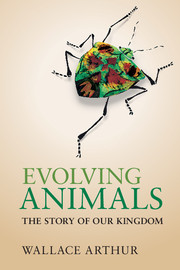Book contents
- Frontmatter
- Dedication
- Contents
- Preface
- Acknowledgements
- 1 What is an animal?
- 2 Before there were animals
- 3 How to make a fossil
- 4 The Cambrian explosion
- 5 How to make a species
- 6 Jellyfish and their kin
- 7 How to make a tree
- 8 The enigmatic urbilaterian
- 9 Animal symmetry and heads
- 10 A plethora of worms
- 11 Trends in animal complexity
- 12 Where the octopus is king
- 13 How to make an animal
- 14 Exoskeletons galore
- 15 Extinction
- 16 Mouth first, mouth second
- 17 Comparing embryos
- 18 Larvae, mouthparts and moulting
- 19 The animal toolkit
- 20 Vertebrate origins and evolution
- 21 From water to land to water
- 22 Variation and inheritance
- 23 Evolutionary novelties
- 24 Human origins and evolution
- 25 Animal plasticity
- 26 The nature of adaptation
- 27 The direction of evolution
- 28 Animal extremophiles
- 29 Extraterrestrial animals?
- 30 The ghost in the machine
- Appendix
- References
- Index
15 - Extinction
Published online by Cambridge University Press: 05 August 2014
- Frontmatter
- Dedication
- Contents
- Preface
- Acknowledgements
- 1 What is an animal?
- 2 Before there were animals
- 3 How to make a fossil
- 4 The Cambrian explosion
- 5 How to make a species
- 6 Jellyfish and their kin
- 7 How to make a tree
- 8 The enigmatic urbilaterian
- 9 Animal symmetry and heads
- 10 A plethora of worms
- 11 Trends in animal complexity
- 12 Where the octopus is king
- 13 How to make an animal
- 14 Exoskeletons galore
- 15 Extinction
- 16 Mouth first, mouth second
- 17 Comparing embryos
- 18 Larvae, mouthparts and moulting
- 19 The animal toolkit
- 20 Vertebrate origins and evolution
- 21 From water to land to water
- 22 Variation and inheritance
- 23 Evolutionary novelties
- 24 Human origins and evolution
- 25 Animal plasticity
- 26 The nature of adaptation
- 27 The direction of evolution
- 28 Animal extremophiles
- 29 Extraterrestrial animals?
- 30 The ghost in the machine
- Appendix
- References
- Index
Summary
Individual animals are born and die; the same applies to species. Admittedly, the birth of a species through speciation – which we looked at in Chapter 5 – and its death through extinction – our subject here – are very different processes from individual births and deaths. Nevertheless, species, like individuals, are bounded in time: they have a start-point, a finite duration, and an end-point. The duration of a species’ existence would be impossible to predict at its inception: it might be less than a million years, or more than 10 million. The fossil record suggests that a few species remain in existence for over 100 million years – these are sometimes called living fossils, because the extant animal of today resembles so closely a fossil form that may be its ancestor of the distant past. The arthropod called the horseshoe crab is a case in point (Figure 15.1).
Extinction is a multi-level phenomenon. In the above introduction, I focused on the level of the species. But we can use the word extinction to refer to groups of animals both above and below the species level. This chapter will include both of these usages. And in fact we’ll start with groups below the species, because this helps to reveal that ultimately extinction is an ecological process, just as much as it is an evolutionary one. In a sense, the mechanism of extinction is ecological while its result is evolutionary.
- Type
- Chapter
- Information
- Evolving AnimalsThe Story of our Kingdom, pp. 146 - 155Publisher: Cambridge University PressPrint publication year: 2014



